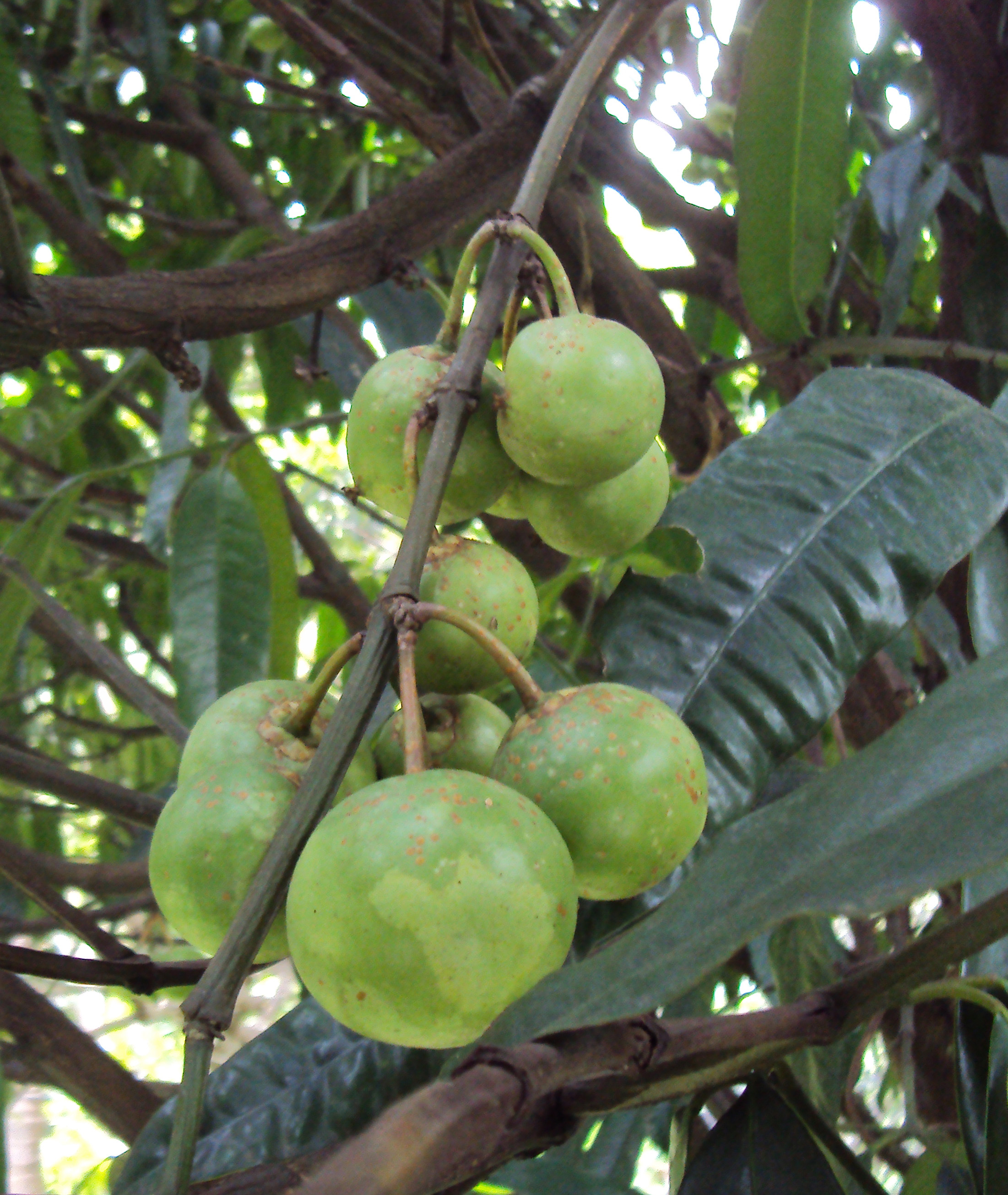|
Clusiaceae
The Clusiaceae or Guttiferae Juss. (1789) (''nom. alt. et cons.'' = alternative and valid name) are a family of plants including 13 genera and ca 750 species. Several former members of Clusiacae are now placed in Calophyllaceae and Hypericaceae. They are mostly trees and shrubs, with milky sap and fruits or capsules for seeds. The family is primarily tropical. More so than many plant families, it shows large variation in plant morphology (for example, three to 10, fused or unfused petals, and many other traits). According to the APG III, this family belongs to the order Malpighiales. One feature which is sometimes found in this family, and rarely in others (e.g., Malpighiaceae), is providing pollinators with rewards other than pollen or nectar; specifically, some species offer resin which bees use in nest construction (all three rewards are found in different species of the Clusiaceae). Taxonomic history The family Clusiaceae was divided by Cronquist into two subfamilies: ... [...More Info...] [...Related Items...] OR: [Wikipedia] [Google] [Baidu] |
Clusia
''Clusia'' is the type genus of the plant family Clusiaceae. Comprising 300-400 species, it is native to the tropics of the Americas. The genus is named by Carl Linnaeus in honor of the botanist Carolus Clusius. The closest relatives of ''Clusia'' are the neotropical genera ''Chrysochlamys'', ''Tovomita'', ''Dystovomita'' and ''Tovomitopsis''. Together with ''Clusia'', these genera form the tribe Clusieae, where the fruit is a fleshy capsule with arillate seeds. The distribution ranges from the Florida Keys and southern Mexico to southernmost Brazil, and from near sea level to at least 3500 m altitude in the northern Andes. Species of ''Clusia'' are a characteristic component of a number of Neotropical vegetation types, and may even be dominant, as is often seen in montane forests of the Greater Antilles. Most species are found in lowland or montane rainforests, but some occur in drier habitats such as the restingas of Brazil, caribbean coastal scrub and dry interandean vall ... [...More Info...] [...Related Items...] OR: [Wikipedia] [Google] [Baidu] |
Tovomita
''Tovomita'' is a genus of flowering plants in the family Clusiaceae. They are noted for having white-yellow latex and containing xanthones. The genus is distributed in the tropical Americas, with many occurring in Venezuela. Most are native to the forests of the Amazon.BGCI publishes Red List of Neotropical genus ''Tovomita''. Botanic Gardens Conservation International. Most ''Tovomita'' species are trees, and a few are shrubs. They sometimes have s. There are monoecious and dioecious species.Cuello, N. L [...More Info...] [...Related Items...] OR: [Wikipedia] [Google] [Baidu] |
Malpighiales
The Malpighiales comprise one of the largest orders of flowering plants, containing about 36 families and more than species, about 7.8% of the eudicots. The order is very diverse, containing plants as different as the willow, violet, poinsettia, manchineel, rafflesia and coca plant, and are hard to recognize except with molecular phylogenetic evidence. It is not part of any of the classification systems based only on plant morphology. Molecular clock calculations estimate the origin of stem group Malpighiales at around 100 million years ago ( Mya) and the origin of crown group Malpighiales at about 90 Mya. The Malpighiales are divided into 32 to 42 families, depending upon which clades in the order are given the taxonomic rank of family. In the APG III system, 35 families were recognized. Medusagynaceae, Quiinaceae, Peraceae, Malesherbiaceae, Turneraceae, Samydaceae, and Scyphostegiaceae were consolidated into other families. The largest family, by far, is the Euphorbiaceae, ... [...More Info...] [...Related Items...] OR: [Wikipedia] [Google] [Baidu] |
Allanblackia
''Allanblackia'' is a genus of flowering plant in the family Clusiaceae. Molecular phylogenetic analyses indicate that is it nested in the dioecious ''Garcinia''. The genus name commemorates Allan Black. It contains the following species: * ''Allanblackia floribunda'' (Nigeria to DR Congo and Angola) * ''Allanblackia gabonensis'' * ''Allanblackia kimbiliensis'' * ''Allanblackia kisonghi'' * ''Allanblackia marienii'' * ''Allanblackia parviflora'' (Upper Guinea, from Ghana westwards) * ''Allanblackia staneriana'' * ''Allanblackia stuhlmannii'' (Eastern arc mountains -Usambara Tanzania) * ''Allanblackia ulugurensis'' (Eastern arc mountains -Uluguru Tanzania) Uses Allanblackia can be processed into Allanblackia oil References Allanblackia, Malpighiales genera Taxonomy articles created by Polbot Dioecious plants {{Clusiaceae-stub ... [...More Info...] [...Related Items...] OR: [Wikipedia] [Google] [Baidu] |
Chrysochlamys
''Chrysochlamys'' is a plant genus of the family Clusiaceae. Synonymy The monotypic In biology, a monotypic taxon is a taxonomic group (taxon) that contains only one immediately subordinate taxon. A monotypic species is one that does not include subspecies or smaller, infraspecific taxa. In the case of genera, the term "unispec ... genus ''Balboa'' Planch. & Triana has been put in synonymy with ''Chrysochlamys''. Species Species include: Clusiaceae Malpighiales genera Taxa named by Eduard Friedrich Poeppig {{Clusiaceae-stub ... [...More Info...] [...Related Items...] OR: [Wikipedia] [Google] [Baidu] |
Podostemaceae
Podostemaceae (riverweed family), a family in the order Malpighiales, comprise about 50 genera and species of more or less thalloid aquatic herbs. Distribution and habitat They are found mostly in tropical and subtropical areas worldwide. Many species are found in a very small geographic area, often even just a single river or waterfall. Because of their small range, many species are seriously threatened, especially from habitat loss (for example, due to dams flooding their habitat). Riverweeds adhere to hard surfaces (generally rock) in rapids and waterfalls of rivers. They are submerged when water levels are high, but during the dry season they live a terrestrial existence, flowering at this time. Their root anatomy is specialized for the purpose of clinging to rocks, and in fact details of the root structure are one of the ways of classifying riverweeds. Ecology In many rivers, Podostemaceae are an important food source for a wide range of animals. For example, the tadp ... [...More Info...] [...Related Items...] OR: [Wikipedia] [Google] [Baidu] |
Clusia Rosea
''Clusia rosea'', the autograph tree, copey, cupey, balsam apple, pitch-apple, and Scotch attorney, is a tropical and sub-tropical flowering plant species in the family Clusiaceae. The name '' Clusia major'' is sometimes misapplied to this species. Description ''Clusia rosea'' is a tree native to the Caribbean, including the Bahamas, Hispaniola (such as in Los Haitises National Park), Cuba, Puerto Rico, and Florida.“Clusia rosea”, Pacific Island Ecosystems at Risk (PIER) http://www.hear.org/pier/species/clusia_rosea.htm”Clusia Native Range” http://www.plantmaps.com/nrm/clusia-rosea-florida-clusia-native-range-map.php It is a hemiepiphyte; that is, it grows as an epiphyte on rocks or other trees at the start of its life and behaving like a strangler fig as it gets larger. Like a strangler fig, it successfully competes for light by outgrowing, overtopping and "strangling" its host tree with its many aerial roots. The petals are pink to white. The thin upper leaf tissue r ... [...More Info...] [...Related Items...] OR: [Wikipedia] [Google] [Baidu] |
Tovomitopsis
''Tovomitopsis'' is a genus of flowering plant in the family Clusiaceae. Some species have been synonymized to the genus ''Chrysochlamys''. Species * '' Tovomitopsis allenii'' * ''Tovomitopsis angustifolia'' * '' Tovomitopsis centistaminibus'' * ''Tovomitopsis colombiana'' * '' Tovomitopsis costaricana'' * ''Tovomitopsis croatii'' * ''Tovomitopsis faucis'' * '' Tovomitopsis glauca'' * '' Tovomitopsis guatemaltecana'' * '' Tovomitopsis macrophylla'' * ''Tovomitopsis membranacea'' * ''Tovomitopsis membrillensis ''Tovomitopsis membrillensis'' is a species of flowering plant in the family Clusiaceae. It is found only in Panama Panama ( , ; es, link=no, Panamá ), officially the Republic of Panama ( es, República de Panamá), is a transcontine ...'' * '' Tovomitopsis micrantha'' * '' Tovomitopsis multiflora'' * '' Tovomitopsis myrcioides'' * '' Tovomitopsis nicaraguensis'' * '' Tovomitopsis paniculata'' * '' Tovomitopsis psychotriaefolia'' * '' Tovomitopsis psychotriif ... [...More Info...] [...Related Items...] OR: [Wikipedia] [Google] [Baidu] |
Dystovomita
''Dystovomita'' is a genus of flowering plants belonging to the family Clusiaceae The Clusiaceae or Guttiferae Juss. (1789) (''nom. alt. et cons.'' = alternative and valid name) are a family of plants including 13 genera and ca 750 species. Several former members of Clusiacae are now placed in Calophyllaceae and Hypericaceae. .... Its native range is Central and Southern Tropical America. Species: *'' Dystovomita clusiifolia'' *'' Dystovomita paniculata'' References {{Taxonbar, from=Q3764359 Clusiaceae Malpighiales genera ... [...More Info...] [...Related Items...] OR: [Wikipedia] [Google] [Baidu] |
Garcinia
''Garcinia'' is a genus of flowering plants in the family Clusiaceae native to Asia, America, Australia, tropical and southern Africa, and Polynesia. The number of species is disputed; Plants of the World Online (POWO) recognise up to 400. Commonly, the plants in this genus are called saptrees, mangosteens (which may also refer specifically to ''Garcinia mangostana''), garcinias, or monkey fruit. Many species are threatened by habitat destruction, and at least one species, '' G. cadelliana'', from South Andaman Island, is almost or even completely extinct already. The fruits are a food source for several animals, such as the archduke butterflies (''Lexias'' spp.) of tropical eastern Asia which relish the sap of overripe mangosteens. The genus is named after French botanist Laurent Garcin (1683–1751). Description ''Garcinia'' species are evergreen trees and shrubs, dioecious and in several cases apomictic. The fruit is a berry with fleshy endocarp, which in several species is ... [...More Info...] [...Related Items...] OR: [Wikipedia] [Google] [Baidu] |
Calophyllaceae
Calophyllaceae is a family of flowering plants in the order Malpighiales and is recognized by the APG III system of classification. Most of the 14 genera and 475 species included in this family were previously recognized in the tribe Calophylleae of the family Clusiaceae. The Angiosperm Phylogeny Group The Angiosperm Phylogeny Group (APG) is an informal international group of systematic botanists who collaborate to establish a consensus on the taxonomy of flowering plants (angiosperms) that reflects new knowledge about plant relationships disc ... determined that splitting this clade of genera off into their own family was necessary. References External links Malpighiales families {{Calophyllaceae-stub ... [...More Info...] [...Related Items...] OR: [Wikipedia] [Google] [Baidu] |
Malpighiaceae
Malpighiaceae is a family of flowering plants in the order Malpighiales. It comprises about 73 genera and 1315 species, all of which are native to the tropics and subtropics. About 80% of the genera and 90% of the species occur in the New World (the Caribbean and the southernmost United States to Argentina) and the rest in the Old World (Africa, Madagascar, and Indomalaya to New Caledonia and the Philippines). One useful species in the family is '' Malpighia emarginata'', often called acerola. The fruit is consumed in areas where the plant is native. The plant is cultivated elsewhere for the fruit, which is rich in vitamin C. Another member of the family, caapi or yagé (''Banisteriopsis caapi''), is used in the entheogenic brew known as ayahuasca. One feature found in several members of this family, and rarely in others, is providing pollinators with rewards other than pollen or nectar; this is commonly in the form of nutrient oils (resins are offered by Clusiaceae). Genera * ... [...More Info...] [...Related Items...] OR: [Wikipedia] [Google] [Baidu] |





